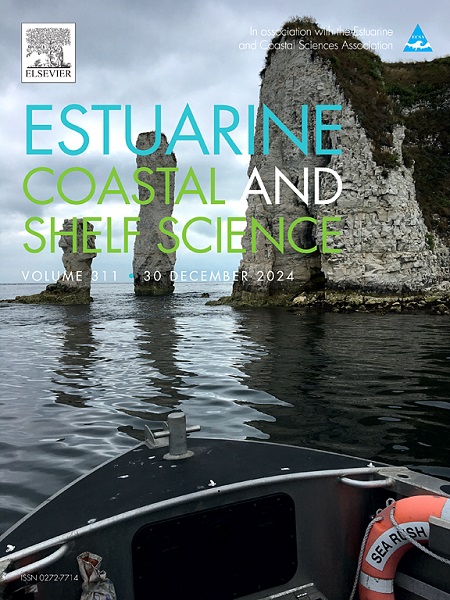Munitions mobility and burial in a microtidal estuary
IF 2.6
3区 地球科学
Q1 MARINE & FRESHWATER BIOLOGY
引用次数: 0
Abstract
Field tests were performed to observe mobility and burial of underwater unexploded ordnances (UXOs) in a microtidal estuary, characterized by multiple forcings and mixed sediments. Such characteristics distinguish the site from others usually studied in the literature, making the analysis very complex. Observations highlighted the large dependence of UXO behavior on the bed sediments. UXOs placed on the muddy riverbed got buried almost instantaneously, without moving. Just the smallest and least dense UXO experienced some migration (maximum 10 m) and re-exposure episodes. On the other hand, UXOs remained proud on the sandy seabed, until a wave storm produced bed fluidization that caused their complete burial. Field observations, together with data collected by an integrated monitoring system operating in the study area, provided a baseline dataset for the validation of predictive models of UXO motion. The Underwater Munitions Expert System (UnMES), forced with Delft3D hydro-morphodynamic results, was run to simulate the behavior of light, medium, and heavy UXO types during a sea storm. Results agreed well with observations, predicting complete burial and minimal migration (0–5 m).
微潮河口弹药流动与掩埋
在具有多重强迫和混合沉积物特征的微潮河口进行了现场试验,以观察水下未爆弹药的流动性和埋藏情况。这些特征将该遗址与文献中通常研究的其他遗址区分开来,使分析变得非常复杂。观察结果强调了未爆弹药的行为在很大程度上依赖于床沉积物。放置在泥泞河床上的未爆弹药几乎在瞬间被掩埋,没有移动。只有最小和密度最低的未爆弹药经历了一些迁移(最大10米)和再暴露事件。另一方面,未爆弹药在沙质海床上保持着骄傲,直到一场海浪风暴产生了床流化,导致它们完全被埋葬。实地观测加上在研究地区运行的综合监测系统收集的数据,为验证未爆弹药运动预测模型提供了基线数据集。水下弹药专家系统(UnMES)与Delft3D水形态动力学结果一起运行,以模拟海上风暴期间轻型、中型和重型未爆弹药类型的行为。结果与观测结果一致,预测完全埋藏和最小迁移(0-5 m)。
本文章由计算机程序翻译,如有差异,请以英文原文为准。
求助全文
约1分钟内获得全文
求助全文
来源期刊
CiteScore
5.60
自引率
7.10%
发文量
374
审稿时长
9 months
期刊介绍:
Estuarine, Coastal and Shelf Science is an international multidisciplinary journal devoted to the analysis of saline water phenomena ranging from the outer edge of the continental shelf to the upper limits of the tidal zone. The journal provides a unique forum, unifying the multidisciplinary approaches to the study of the oceanography of estuaries, coastal zones, and continental shelf seas. It features original research papers, review papers and short communications treating such disciplines as zoology, botany, geology, sedimentology, physical oceanography.

 求助内容:
求助内容: 应助结果提醒方式:
应助结果提醒方式:


